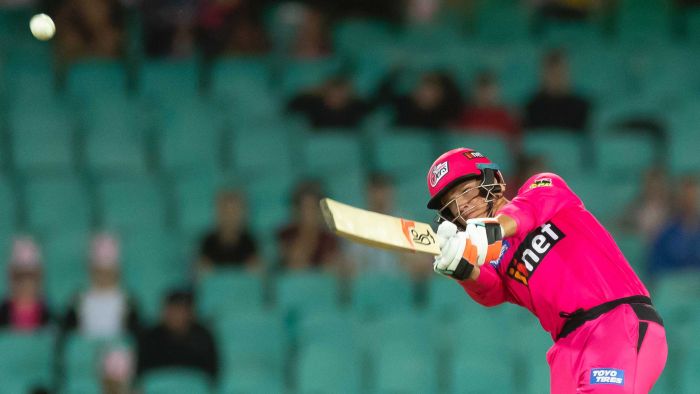The significant aspect of the strong response to the gimmicky additions to this season’s Big Bash League (BBL) rules is just that — people care sufficiently about the format and the competition to have a response.
The introduction of the Power Surge, X-Factor Player and Bash Boost to the BBL has prompted the sort of debate that grips the AFL each season when yet more incremental changes to interchange or encroachments on the mark are trialled; or in golf between those hoping Bryson DeChambeau is the first man to land a golf ball on the moon and those who want the integrity of traditional courses protected from wedge-wielding behemoths.
But regardless of whether you are intrigued or horrified by the BBL innovations, an argument about compromising the sacred traditions of Twenty20 cricket would have once seemed about as likely as naming the trophy the Chris Tavare Cup.
Loading
Just 13 years ago the inclusion of NRL star Andrew Johns as a celebrity participant in the NSW team in the BBL’s state-based predecessor was considered all part of the fun and frivolity of a format only slightly more exalted than backyard cricket.
“The states see Twenty20 as an opportunity to be as left field as possible,” said then-Cricket NSW chief executive Dave Gilbert of Johns’s inclusion.
“Nobody loses sleep if they win or lose.”
Admittedly, Australian cricket was unusually slow to realise that the (even more) limited overs version would quickly become a significant part of the game’s ecosystem.
While England and then India began to position T20 in their domestic and international plans, Australian players were taking the field for light-hearted internationals with their nicknames on the backs of their shirts and performing slapstick impersonations of former greats.
But subsequently, in defiance of the doomsday forecasts of bloody-minded traditionalists such as myself, T20 cricket has not merely survived but thrived — beyond even the obvious commercial benefits provided by the Indian Premier League, BBL and other franchise-based tournaments.
The Women’s T20 World Cup final at a packed MCG last March was a spectacular tribute to the growth of women’s cricket and the wise investment in the Australian team particularly, but also further validation of T20 itself.
Similarly the success of the WBBL in a country where women’s professional sports leagues have struggled for both visibility and viability has been made possible by T20’s concurrent growth.
You might argue that the emphasis on T20 and ODI cricket has entrenched limited and opportunistic scheduling that deprives the women’s game of regular Test cricket.
But as the rapid improvement in the quality of women’s cricket continues and female participation rates increase there is genuine hope T20 cricket might actually increase the long-term possibility of meaningful women’s Test cricket as the talent pool deepens.
T20 driving participation numbers
At the most significant levels — junior and club cricket — T20 cricket, or modified versions thereof, have become an increasingly important in halting once faltering participation and retention rates.
As the BBL caters to the reduced concentration spans of some spectators or new cricket converts, T20 is providing — if you will pardon the jargon — an “immersive experience” for kids who might otherwise be poached by rival sports or, as likely, stay glued to their PlayStations.
At the same time, T20 is inevitably emerging at club level as an alternative (rather than a replacement) for traditional two-day fixtures or even longer-form one dayers in the lower levels in response to demands from “time poor” players.
Even conservative associations are realising not everyone now has six hours over two consecutive weekends to spend hitting a few shots or standing at mid-on, and T20 will inevitably help clubs fill the need for quicker weekend and even weeknight cricket.




The sum of T20’s various applications is that it has done far more than provide the kind of carefree circus Gilbert and others envisaged when they called up Joey Johns and filled niches the formats commercially-minded inventors probably had not even considered.
So when the BBL applies a thick layer of new rules to what is still a reasonably uncomplicated game it is not putting lipstick on a pig. Rather, it risks giving a format with an already appealing visage a dodgy facelift.
The motivation for the changes seems obvious, even justifiable — a decline in crowds and viewing figures in recent seasons.
Although this seems more a case of the BBL finding its true level in a crowded sporting marketplace as well as some fan fatigue from the elongated scheduling that saw the tournament dawdle beyond its January sweet spot into mid-February.
There is also the underlying commercial compulsion to give the rights holders Seven and Fox Sports extra bang for their BBL buck in the COVID-disrupted season, even if both have signed watertight long-term contracts.
Time will tell whether a well-executed Power Surge or the perfectly timed introduction of an X-Power player creates the kind of excitement that reverses viewing trends.
But before the first of four Bash Boost points are allocated, there is legitimate concern the changes will take an uncomplicated but now widely popular format back to its gimmicky roots and in turn undermine T20’s steady reputational improvement.
Host Kelli Underwood and the Offsiders panel will analyse all the latest sports news and issues at 10:00am Sunday on ABC TV.







